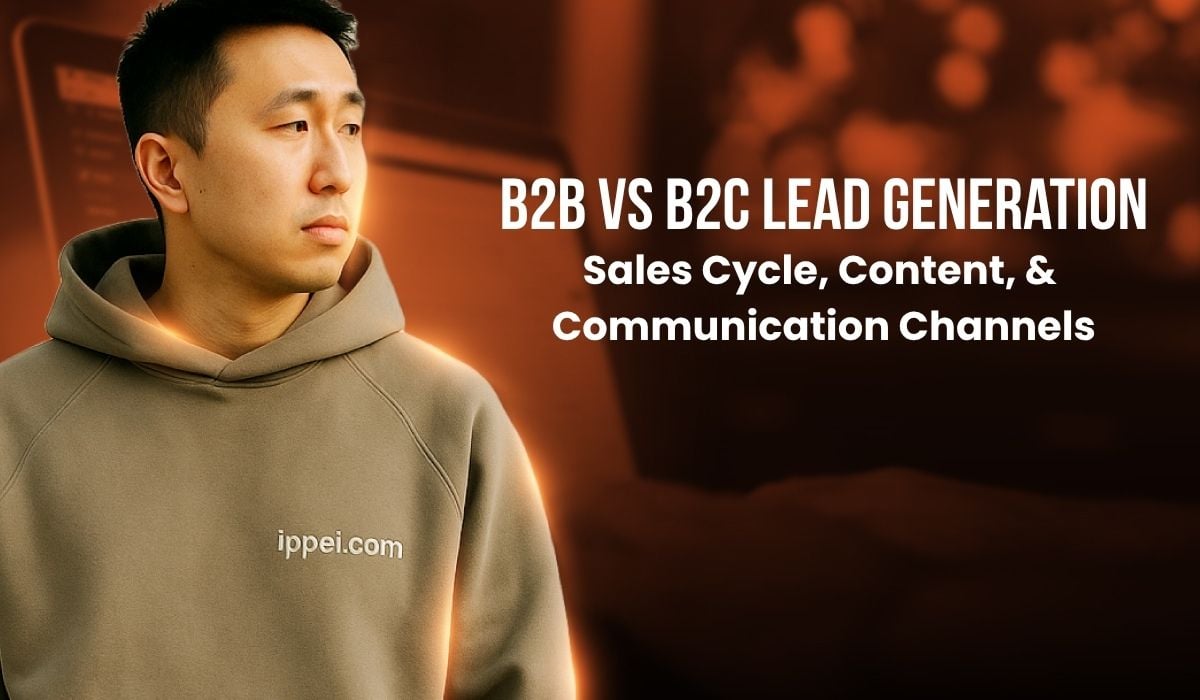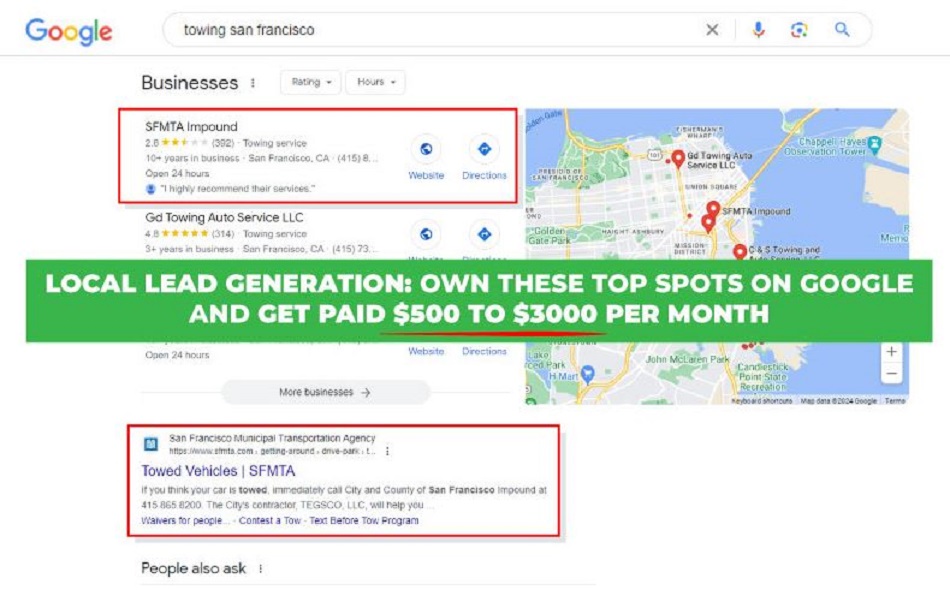B2B VS B2C Lead Generation | Sales Cycle, Content, & Communication Channels

B2B Lead Generation | B2C Lead Generation | |
|---|---|---|
Sales cycle length | Weeks to months | Days to weeks |
Content and messaging | Informational | Engagement-focused |
Communication channels | Where professionals are, like LinkedIn | Where general consumers are, like Facebook |
Lead quantity | Lower quantity, higher quality | Lower quality, higher quantity |
Measurement methods | Focus on lead quality and engagement depth | Focus on lead volume and conversion speed |
Difficulty | Higher | Lower |
The difference between B2B and B2C lead generation is that B2B lead generation requires relationship-drive strategies, while B2C lead generation focuses on quicker, more emotional marketing.
B2B lead generation is generating customers that are businesses. A B2B lead generation example is Templafy. Templafy is a Denmark-based document generation platform for businesses. Templafy uses a combination of Sponsored Content on LinkedIn and account based marketing to find businesses interested in its product, according to a study by LinkedIn Marketing Solutions.
B2C lead generation is generating customers who are consumers. A B2C lead generation example is Angi (formerly Angie’s List). Angi generates and sells leads to home service businesses like plumbers, electricians, and general contractors.
I’ve been doing lead generation for over a decade now. Primarily, I’ve done B2C lead generation using the local lead generation business model. In the following article, I compare generating B2B leads and B2C leads so you can decide which audience your lead generation business should focus on.
1. B2C Lead Generation Has a Shorter Sales Cycle
B2B lead generation typically requires a more prolonged sales cycle than B2C lead generation.
The B2B lead generation process often requires multiple months before reaching a purchase decision. B2B sales cycles are extensive because there are multiple decision makers involved, and products are more complex and costly.
On average, B2B sales require interactions with 7 stakeholders from various departments, according to KickScale. As such, the strategy for lead qualifying and lead nurturing is more involved. B2B products and services are often custom tailored to fit the needs of a business, which is a reason additional time is required to generate a sale. Consider the example of a construction contractor ordering industrial machinery for a project. This business owner would need to work with the industrial machinery company to understand which equipment they need for the project and how the new equipment would integrate with their current equipment.
The B2C lead generation process requires a few days to a few weeks. That’s because B2C transactions require consideration from one individual and maybe their family.
B2C purchase decisions are often based on immediate need for a product or service. Consider a homeowner with a clogged toilet. When they call a plumber to fix the situation, they think little about whether they should use the service. Instead, they order the plumber immediately.
2. B2B Lead Generation Leverages Informational Content
B2B lead generation tends to use more informational content, while B2C focuses on engaging content.
B2B lead generation tactics involve content formats that educate potential clients on the benefits of the product or service being sold. With B2B lead generation, you typically see content like whitepapers, case studies, and technical webinars being used in the digital marketing strategy. These types of content incorporate a professional tone and include industry-specific jargon that the target audience would understand. The messaging focuses on how the product or service can positively impact a business, such as highlighting average ROI of existing customers.
Look at the messaging of ActiveCampaign, an email marketing software for businesses. ActiveCampaign mentions on its website homepage that businesses leveraging its service save 20 hours per month on average.
B2C lead generation content is typically made for a more general audience, with content that is easy to understand. It often uses a conversational tone to connect with the audience emotionally and spur engagement. The messaging is designed to get viewers to take action quickly, incorporating promotions and direct calls to action (CTAs). It highlights the benefits the consumer can enjoy if they purchase it.
The website messaging of Arizona State University provides a good example of B2C lead generation messaging. Benefits like “join a community” and “learn new skills” are highlighted front and center.
3. B2C Lead Generation Leverages Marketing Channels With Broader Audiences
B2B lead generation tactics target channels where companies and professionals spend time, while B2C lead generation leverages channels with broader reach.
The most common marketing channels for B2B lead generation include LinkedIn, online workshops, webinars, industry trade shows, conferences, and professional publications. These are the channels where business-focused people can be directly reached, allowing for optimal lead generation performance. LinkedIn is an especially popular B2B lead generation channel. The majority 82% of B2B marketers report it as one of the most effective channels, according to SalesHandy.
A lead generator on Reddit mentions having better success running LinkedIn Ads versus Google Ads in terms of PPC advertising. They note that LinkedIn produces higher-quality leads.
B2C lead generation targets customers through broad marketing channels. These include social media platforms like Instagram, Facebook, and TikTok, paid search, display advertising, TV, radio, influencer marketing, blog content, and SMS. These marketing channels cast a wide net to reach the largest audience possible who might be interested in a product or service.
4. B2B Lead Generation Attracts Higher Quality Leads
B2B lead generation typically results in fewer leads but higher quality while B2C lead generation attracts more leads but lower quality.
Data from Databox shows that B2B companies generate around 27 leads per month on average from online marketing. In contrast, B2C companies were found to generate 196.5 leads per month on average.
Even so, the conversion rate of B2B lead generation is typically higher, as highlighted by a report by RulerAnalytics. When comparing the conversion rate of direct traffic for B2B services and B2C services, RulerAnalytics finds that B2B services average a 2.7% conversion rate while B2C services average just 1.7%. Direct traffic means the people that search for a brand website directly instead of clicking to it through another marketing channel.
The two leading marketing channels of paid search and SEO show the same trend when comparing B2B and B2C service conversion rates. The average conversion rate of paid search is 3.4% for B2B services and just 0.9% for B2C services. For organic search, the average conversion rate is 2.3% for B2B services and just 1% for B2C services.
5. B2C Lead Generation Focuses on Measuring Lead Volume and Speed
B2B lead generation metrics focus on measuring quality and engagement depth, while B2C lead generation metrics typically emphasize volume and conversion speed. The common metrics to track for B2B lead generation include:
- Lead scoring: B2B companies often score leads based on their likelihood of buying as they move through the sales pipeline based on factors like engagement level, company size, and ability to make purchase decisions.
- Customer lifetime value (CLV): Measures how much a customer pays the business during the entire relationship. It’s important for B2B companies to track this metric because a single customer can make substantial purchases over time. As such, B2B businesses want to target customers that match the profile of their current customers with high CLV to maximize long-term profits.
- Cost of acquisition (CAC): The average cost of acquiring a new customer. B2B lead generation can generate high expenses per lead, so it’s essential to track this metric to avoid investing too many resources in a single opportunity.
The common metrics to track for B2C lead generation include:
- Traffic to lead ratio: Measures the effectiveness of attracting customers through digital platforms and converting them into customers. B2C lead generators use this metric as a benchmark to gauge the effectiveness of marketing efforts over time.
- Engagement rate: The percentage of the audience that sees marketing content and interacts with it. B2C lead generation often leverages website content and social media content. Higher engagement indicates the content resonates with the audience and they are more likely to purchase a B2C product.
6. B2B Lead Generation Is Difficult
B2B lead generation is considered more challenging overall than B2C lead generation.
B2B lead generation targets potential customers from small target markets. There is high sales friction because there are many decision makers in the process and products are typically more costly. As such, there are less potential opportunities available and it takes longer to know whether an opportunity you’re pursuing is worth it.
In response to a Reddit user asking for help learning B2C lead generation, one marketer comments that B2C lead generation is much easier, so the OP should try B2B lead generation for their own business first. They would likely find B2C lead generation much easier after this experience.
Is It Better to Generate Leads for B2B or B2C Companies?
It’s better to generate leads for B2B companies when a lead generation business has specific industry expertise and a strong sales team. It’s better to generate leads for B2C companies when a lead generation business has marketing expertise but no industry expertise or sales infrastructure.
Although B2B lead generation can be lower competition, it requires that a business has a more intricate understanding of the industry and customer pain points to generate high-quality leads. These leads require a more comprehensive nurturing process that requires a qualified sales team to manage. As such, smaller scale lead generation businesses without many resources are better suited to generate B2C leads.
What Are the Top Lead Generation Mistakes to Avoid for B2B? B2C?
The top B2B lead generation mistakes to avoid are:
- Targeting too broadly because the target audience isn’t well defined
- Ignoring the buyer journey and not understanding where to place optimal touchpoints
- Lack of coordination between the sales and marketing teams
- Presenting prospects with unprofessional looking website and marketing materials
The top B2C lead generation mistakes to avoid are:
- Investing in efficient marketing channels
- Skipping qualifying leads
- Poor leads nurturing
- Not tracking results
Is a B2B or B2C Lead Generation Business More Profitable?
A B2C lead generation business is more profitable than a B2B lead generation business. That’s because B2B leads require more resources for nurturing than B2C leads. This cuts into profitability because B2B marketers need to invest more money to convert each lead.
A
lead generation business is profitable
in most cases. The average cost for a lead across all industries is $198.44, according to Exploding Topics. Generating and selling leads can be highly lucrative because many businesses will pay well for quality leads. Just look at the profitability of Angi Inc., one of the largest lead generators in the USA. Angi generated a net income of $36 million on a profit margin of 3% in 2024.
Conclusion: Why Local Lead Generation Is the Best Online Business to Start in 2025
Local lead generation is the best online business to start because it offers high profits and low competition. The way we teach the local lead generation business model is to generate organic traffic through SEO. This entails setting up websites that attract leads for local service business owners. These websites typically cost a few hundred dollars to set up and rank on the first page of Google. Once ranking and generating traffic, we rent these websites to real business owners for between $500 and $3,000 per month usually.

This business model can reach profit margins of up to 90% because SEO traffic is long lasting. Unlike using PPC advertising, where you need to pay constantly to generate leads, websites ranking with SEO can remain on the first page of Google long term with minimal maintenance. Local lead generation websites can generate leads passively without consistent investment or work like PPC requires.
This business model is great for beginners because it’s much lower competition than other online business models. Typically, you compete against a handful of small local service business owners in one city. Learn how we find low competition opportunities and create websites that can generate thousands of dollars per month with our local lead generation program.

Follow Me
Ippei Kanehara
Founder/CEO
$52K per month providing lead generation services to small businesses
Ippei.com is for digital hustlers, industry leaders and online business owners.
His #1 online business recommendation in 2024, is to build your own lead generation business.
